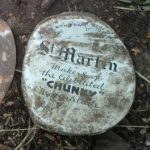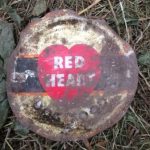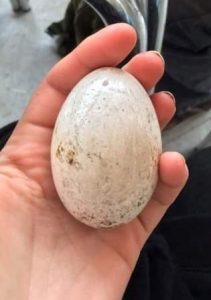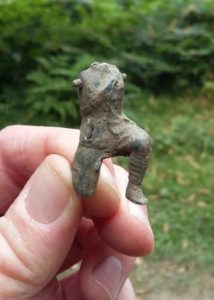The Hundreds and Lathes of the Cobham area
The project area comprises parts of two areas known as ‘hundreds’ whose modern names are Toltingtrough and Shamwell. These and many other hundreds originally fell within a larger area, the ‘lathe’ of Aylesford. Saxon Kent was divided into seven lathes and they were formed several centuries before the hundreds. According to the late K.P. Witney1, the lathes were provinces of the original independent Jutish kingdom of Kent. Each was centred on a royal vil or township which in this case is represented by the present village of Aylesford. Witney noticed that the earliest mention of a lathe was in a grant of AD 6052 which included the vill name Cistelet (Chislet), let being an early form of the word lathe. His implication is that lathes came into existence before or during the 6th century AD.
By AD 785 Kent had ceased to be an independent kingdom. It was under the domination of Mercia by AD 798 but from about AD 825 onwards both kingdoms came under the control of Wessex3. Subdivision of England into hundreds had begun in the kingdom of Wessex but over the period AD 925 to 975 the system was extended throughout the country4. In Kent, the existing Saxon lathes were subdivided, the lathe of Aylesford forming 13 hundreds – and one more was added in the 13th century. The meaning of the word hundred is uncertain but it may originally have contained 100 ‘hides’ of land. Alternatively each hundred may have comprised ten groups of ten men who had the task of keeping order. Each hundred had its own court, which dealt with theft and felony and met every four weeks, presumably in the open air5.
A hundred was quite a large area and precise knowledge of where the hundred courts were held is, to an extent, based upon topography and local folk memory. Fortunately, early examples of the names of Toltingtrough and Shamwell hundreds are numerous from Domesday onwards (we have disregarded DB spellings as being unreliable) and the sites of both hundred courts can be located on modern maps. The Toltingtrough site falls within the project area and the Shamwell site is a kilometre to the north of it.
Twenty-six medieval versions of the name Toltingtrough were found by O.S. Anderson6, who made a study of English hundred names in the 1930s. They are either of the general form Toltentre (1086-1380) or Totingtre (1179-1226). Anderson (citing J K Wallenberg) derived the first element from OE ‘tealt’ = unstable or from MDu ‘touteren’ = tottering but was unconvinced by Wallenberg’s interpretation of the name as the tilting or the tottering tree. However both possibilities seem reasonable to us and amounting to much the same thing. A large tree with a pronounced lean to it must surely have made a good landmark for a meeting place.
Local people still regard the tiny Toltingtrough Green as the hundred meeting point. This is at the junction of four modern roads and near a green lane. Its location is TQ 652689. The 1838 Northfleet tithe schedule lists the field east of Toltingtrough Green as Tollentrough. The Ordnance Survey is inconsistent: Toltingtrough appears on the 6 inch map of 1868 and the 25 inch of 1876; but Tollentrough on the 25 inch of 1908. The Nurstead tithe map and schedule show the field SW of the Green as Great Oak Field, arguably to commemorate the tilting tree? In the same vein, the 1839 Cobham tithe map shows a large isolated tree just to the S. The Green lies on the E boundary of the hundred, but it is reasonably central to the whole hundred N to S and the hundred itself is very narrow E to W at this point. The area is flat and well drained. Toltingtrough hundred contained the modern parishes of Northfleet, Ifield and Nursted.
Twenty medieval versions of the name Shamwell were found by Anderson in his study of English hundred names6. They range between Sammele (1130-1232), Shameleh (1157-1450), Schamele (1219-1300) and Scamel (1199-1226). Anderson prefers to derive the name from OE ‘sc(e)amol’ = bench or stool but he notes an OG meaning of ledge or shelf. Wallenberg agrees with the latter and we feel they better describe the topography for a meeting place.
The 1842 tithe schedule gives Scambels, which must be a mishearing, but the tithe map of the same year shows 4 parcels of this name in a close group: Scambels Wood and Scambels Field are high ground on the east side. Scambels Shaw is on a steep slope to their west and Scambels Home Field is flattish ground west of that. The first two are the likely meeting place and lie at the junction of two roads, two green lanes and a footpath. The Ordnance Survey does not name the site. Local people remember the area as ‘The Scammells’ but do not connect it with the hundred name7.
The location of the meeting point is at TQ 687708 at the junction of four modern roads and two footpaths. The ground in the area is part flat and part steeply sloping, but both are well drained. Shamwell hundred contained the modern parishes of Cobham and Cuxton.
The boundaries of the ancient Kentish hundreds and lathes nowadays appear to follow parish boundaries, at least in the great majority of cases. Obviously though, they cannot have done so. The lathes of Kent are at least 1,400 years old and the hundreds are over a thousand years old, whereas most parish boundaries can only be some 700 to 900 years old. Clearly the process of their formation must have been the other way around.
Also, we have assumed that all three types of boundary followed the same lines on the ground. In fact, the different boundaries may have diverged considerably, or they may never have been defined on the ground at all (and obviously none were defined on a map until relatively modern times). All we really know are the approximate locations of the entities which they enclosed. Except where we can locate and identify any ancient ditches, hedges, walls or fences which once defined those boundaries, we will never know.
(Roger A.C. Cockett, August 2016)
Footnotes
1 Witney, 1976, pp. 31-33.
2 Kings College, London, 2016.
3 Witney, 1982, pp.210 and 215.
4 Jolliffe, 1947, pp.116-122.
5 Sayles, 1970, pp.183-4.
6 Anderson, 1939, pp.115-117.
7 Pers. comm. with T. Bent, R.Hornsby and J. Elford.
Bibliography
Anderson, O. S., 1939. The Hundred-Names of the South-Eastern Counties. Lunds Universitets Arsskrift.
Jolliffe, J.E.A., 1947. The Constitutional History of Medieval England. Adam and Charles Black.
King’s College London, 2016. The Electronic Sawyer: Charter S4. URL:
http://www.esawyer.org.uk/about/index.html
Sayles, G. O., 1970. The Medieval Foundations of England. Methuen.
Witney, K.P., 1976. The Jutish Forest. Athlone Press.
Witney. K.P., 1982. The Kingdom of Kent. Phillimore and Co Ltd.






